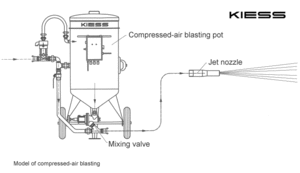2.2.1 Compressed air blasting (also air blast cleaning or sand blasting)
The abrasive is accelerated by an airstream discharging at a high speed.
During this process the abrasive is in a pressure pot. Compressed air is led to it via ducts or hoses; this air is introduced into the pot and it is pressed on the fed abrasive; then it is moved past the pot and connected with a mixing valve.

Model of compressed-air blasting
Click to enlarge!
The abrasive enters the mixing valve vertically via an intake port, or via a flowing angle of about 45°.
After the mixing valve, the actual process of admixing the abrasive and the compressed air starts. This is necessary in order to transport the abrasive from the pressure pot to the object to be blasted.
It is to take care that the speed of the mixture consisting of compressed air/abrasive is not too low so that the heavy parts of the abrasive cannot deposit.
The mixture of abrasive/compressed air leaves the nozzle by a manually led blasting jet at a high speed of up to a maximum of 240 m/s; and afterwards it impinges on the area to be cleaned at this high speed.
The operational pressure necessary to obtain acceleration to the mentioned speed within the nozzle should not be less than 5 b. Nowadays, 10 – 12 b have already been applied at the nozzle.
Compared to the method of airless blast cleaning it is of great advantage that the blasting jet is led and that the object to be blasted can be monitored during derusting.
As regards spaces, the performance is slightly lower. The blasting result is, however, often more favourable for the coating with the applied coating materials, i.e. the surface is getting larger to a greater extent than that one at airless blast cleaning; by this considerably higher sticking can be reached for the coating material. Considerably higher roughness heights can be achieved by high impact energy of each grain caused by the decisively higher discharge speed (240 m/s for pressure blasting, a max. of 80 m/s for airless blast cleaning).
This is even supported by the application of angular blasting grain. In order to obtain the desired levels of purity the nozzle is led faster or more slowly across the surface to be treated. Furthermore, the mixing valve can be changed from 0 to 100% within the inlet cross-section so that different loading factors of the compressed airstream can be obtained by this.
The blasting performance also depends clearly on the following components:
- pressure at the nozzle
- volumetric flow of the abrasive
- flowing out amount of compressed air
- nozzle diameter, nozzle shape.
In order to reach a respectively high volumetric flow of the abrasive a mixing valve is required with high cross-section as well as a respective mixing chamber. Of course, the volumetric flow of the abrasive also depends on the flowing quantity and the speed of the compressed air at the moment of the input of the abrasive into the air flow. The proportion of “quantity of abrasive to the quantity of compressed air” is called the loading factor.
The amount of compressed air depends again on the size of the nozzle inlet and the pressure of the nozzle. Even in recent years, considerable increases in the performance have been reached for the pressure blasting method, and in fact by the application of high-volume blasting pots and appropriate mixing valves as well as by the use of large nozzle diameters, i.e. large amounts of compressed air. The maximum nozzle diameter is 20 mm at present.



